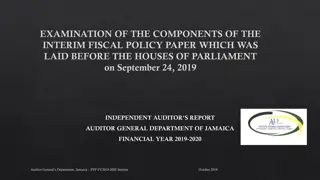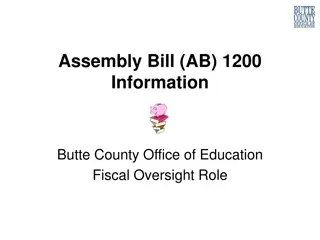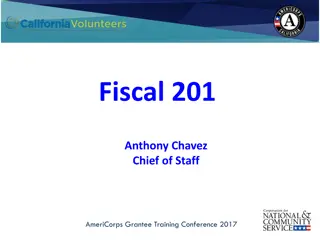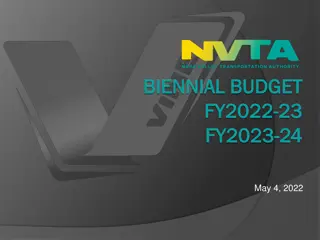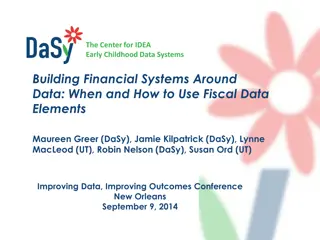
Fiscal Responsibilities in Federal Funding Programs
Explore the fiscal responsibilities involved in federal funding programs, including the concept of supplement, not supplant, factors affecting cost allowability, and the importance of expenses being reasonable and necessary. Learn about allocating costs proportionally and ensuring compliance with regulations to make efficient use of resources.
Download Presentation

Please find below an Image/Link to download the presentation.
The content on the website is provided AS IS for your information and personal use only. It may not be sold, licensed, or shared on other websites without obtaining consent from the author. If you encounter any issues during the download, it is possible that the publisher has removed the file from their server.
You are allowed to download the files provided on this website for personal or commercial use, subject to the condition that they are used lawfully. All files are the property of their respective owners.
The content on the website is provided AS IS for your information and personal use only. It may not be sold, licensed, or shared on other websites without obtaining consent from the author.
E N D
Presentation Transcript
FISCAL RESPONSIBILITIES
AEFLA Section 241(a): Funds made available for adult education and literacy activities under this title shall supplement and not supplant other State or local public funds expended for adult education and literacy activities In other words Federal funds may not be used to pay for services, staff, programs, or materials that would otherwise be paid with state or local funds SUPPLEMENT NOT SUPPLANT
Supplanting would be presumed in these situations: Federal funds used to provide services that were supported by state or local funds in the prior year Federal funds used to provide services the state or local agency is required to make available under other federal, state, or local laws SUPPLEMENT NOT SUPPLANT
FACTORS AFFECTING COST ALLOWABILITY All costs must be Reasonable: incurred by a prudent person, and necessary for the performance of the project Allocable: Charged in accordance with benefits received; proportional Authorized: AEFLA, Uniform Guidance, EDGAR, state or local laws and regulations Adequately documented
REASONABLE AND NECESSARY Practical aspects of reasonable Practical aspects of necessary Is the expense targeted to valid programmatic or administrative considerations? Do I really need this? Surplus property/existing resources Lease vs purchase Do I have the capacity to use what I am purchasing? Is this the minimum amount required to meet my program needs? Did I pay a fair rate? Can I prove it? To what extent is the expense allocable to the grant? If asked to defend this purchase, how would I do it?
Can charge only in proportion to the value or benefits received by the program Example: State purchases a large copier to use 50% in Adult Ed and 50% in a state program can charge only half the cost to federal funds Two Methods of allocating costs: Direct cost allocation Indirect cost allocation ALLOCABLE
DIRECT COSTS OMB UNIFORM GUIDANCE SUBPART E DIRECT COSTS DEFINITION 2 CFR 200.413(a) Direct costs are those costs that can be identified specifically with a particular final cost objective, such as a Federal award, or other internally or externally funded activity, or that can be directly assigned to such activities relatively easily with a high degree of accuracy Direct costs may not also be recovered as indirect costs Examples Examples Direct Instruction: Salary, wages, fringe benefits Travel Rent for direct instruction Materials, text books, software
INDIRECT COSTS OMB UNIFORM GUIDANCE SUBPART A INDIRECT COSTS DEFINITION (2 CFR 200.56) Costs incurred for a common or joint purpose benefitting more than one cost objective, and not readily assignable to the cost objectives specifically benefitted, without effort disproportionate to the results achieved Examples Examples Supervisors: Salary, wages, fringe benefits Human resource functions Computer hardware (general purpose) Facilities costs (space rental, utilities, etc.) Maintenance
Direct vs Indirect Expenses that directly effect the program Expenses that do not have a direct effect on the program Direct Instructor s Supervisor Salary Rent for office manager s space TABE Tests Supply s for the office Rent Direct Cost Indirect Cost
Cost Allowability Challenge In partners, review the list of selected cost items on the hand-out and determine whether each item is allowable or not allowable under federal grants and contracts, as specified in the Uniform Guidance (2 CFR Part 200 Subpart E) The team with the most correct answers wins!
Travel Requirements Travel to annual conference and Program Coordinator meeting required Out of state travel requires approval Per diem will not be reimburse above the state per diem rate
Administrative Cost Limits Not more than five percent of a local grant to an eligible provider can be expended to administer a grant or contract under title II. In cases where five percent is too restrictive to allow for administrative activities, the eligible agency may increase the amount that can be spent on local administration. In such cases, the eligible provider must negotiate with the eligible agency to determine an adequate level of funds to be used for non-instructional purposes
What activities are considered local administrative What activities are considered local administrative costs? costs? Planning Administration, including carrying out performance accountability requirements Professional development Providing adult education and literacy services in alignment with local workforce plans, including promoting co-enrollment in programs and activities under title I, as appropriate; and Carrying out the one-stop partner responsibilities described in 678.420, including contributing to the infrastructure costs of the one- stop delivery system
Indirect Cost Rates must be negotiated with the Department of Education A grantee with indirect rates negotiated by any other agency, limited to 8% Grantees without negotiated indirect rates, may not charge indirect rates to the grant Restricted Indirect Cost Rate









